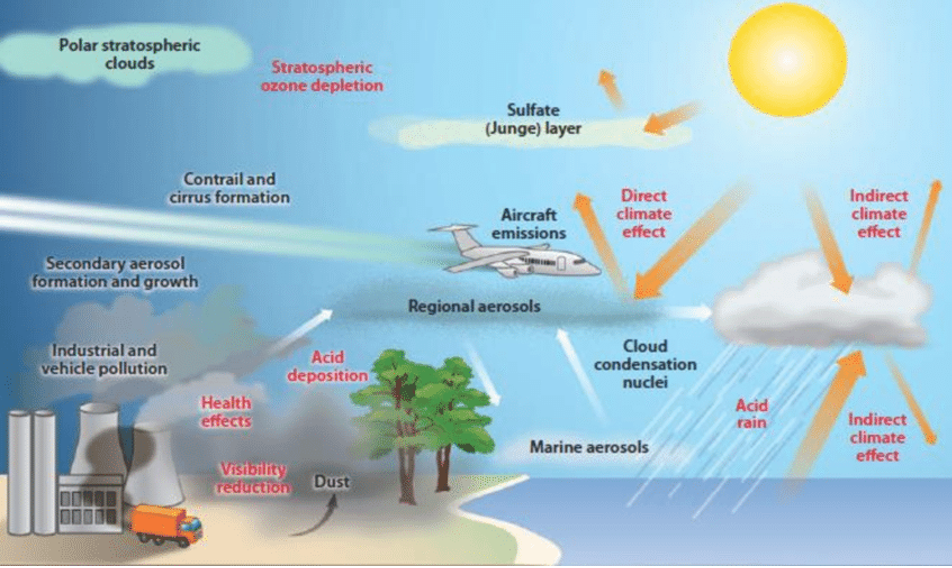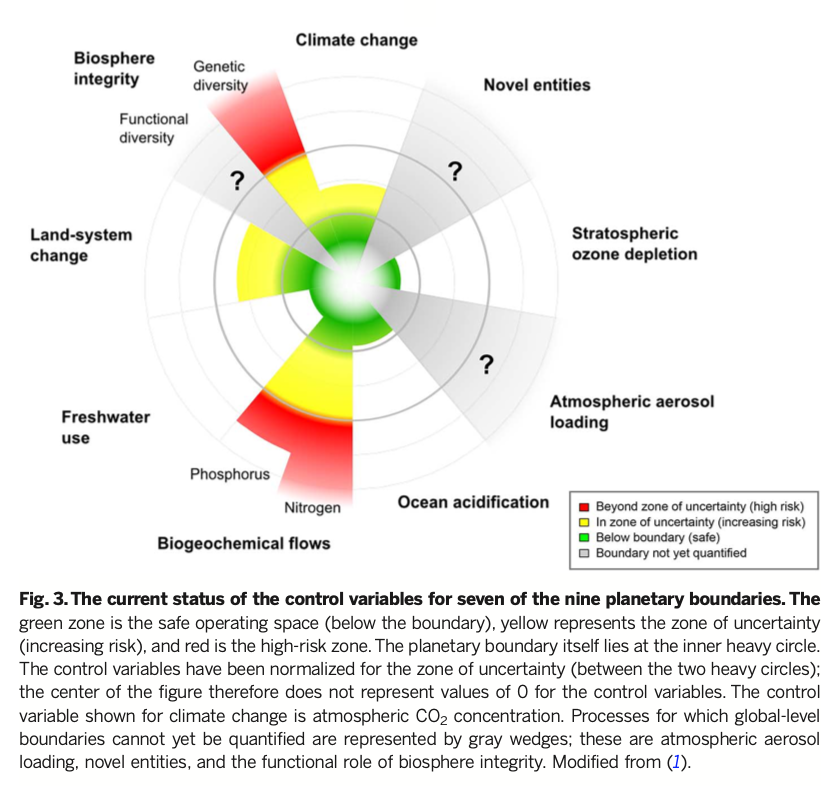Currently, there are nine defined Planetary Boundaries: climate change, ocean acidification, stratospheric ozone depletion, nitrogen/phosphorus cycles (biogeochemical flow boundary), global freshwater use, change in land use, biodiversity loss, atmospheric aerosol loading, and chemical pollution. All of these boundaries are tightly interconnected and have a defined ‘safe operating space’ for humanity.’ If the thresholds for each boundary are crossed this could result in detrimental environmental change.
1) Climate Change: The Earth is currently at an atmospheric carbon dioxide (CO2) concentration of 416.96 parts per million (ppm). Polar sea ice is melting at a faster rate and much earlier in the season than ever before as a result. Anthropogenic changes drive feedback mechanisms such as reductions in ice, decreases in the area in which light can be reflected (albedo), and incidentally increases in the area for light to be absorbed thereby warming the Earth.

2) Ocean Acidification: The ocean acts as a natural carbon sink, in which atmospheric carbon dioxide is absorbed and stored. The surface ocean acidity has increased by 30% since preindustrial times. Approximately 25% of anthropogenically emitted carbon is dissolved in the ocean. When carbon dioxide (CO2) is dissolved in water (H2O), it forms carbonic acid (H2O + CO2 ⮕ H2CO3). Carbonic acid makes the water more acidic, decreasing the pH by changing the chemistry of the ocean. A hydrogen atom (H+) is released when water and carbon dioxide react to form carbonic acid, which is what creates this acidic environment. The increased hydrogen (H+) ions in the water released by the formation of carbonic acid bind to carbonate (CO32-) which then forms bicarbonate (HCO3–). This reaction decreases the carbonate in the water. Carbonate is used by marine animals to make shells and skeletons. This impacts the growth of things like corals and mollusks, which need carbonate to form. Coral provides habitat and nutrition for a plethora of marine life. Reefs also protect coastal areas from storms. Ocean acidification has major consequences to the entire marine food web (reduction in prey for fish leading to a decline in fish stocks and alterations in plankton can lead to harmful algal blooms), while also erasing natural storm protection, and impacting the marine tourism industry.

3) Stratospheric Ozone Depletion: The ozone layer helps to absorb ultraviolet (UV) radiation that is emitted from the sun. It is a layer approximately 15 to 30 kilometers above the surface of the Earth surrounding the entire planet. Ultraviolet radiation can cause direct harm to humans leading to skin cancer and a diminished immune system, while it also causes damage to marine and terrestrial systems by disturbing aquatic food chains and decreasing crop yields. An ozone hole appeared above the Antarctic due to an increase in the emission of ozone-depleting chemicals. The 1987 Montreal Protocol was an international agreement that called for banning chlorofluorocarbons (CFCs) and other ozone-depleting substances to help defend the ozone layer. Recently, there are hopeful signs that the ozone layer is recovering.
4) Nitrogen/Phosphorus Cycles (Biogeochemical Flow Boundary): Nitrogen and phosphorus are two extremely important elements needed for plant growth. The biogeochemical cycles have been affected by these two elements due to anthropogenic agricultural and industrial uses. Fertilizer manufacturing and use has increased for application to crops, which can be harmful to the environment. Nitrogen naturally resides in the atmosphere, but due to human activity it is now being converted into reactive forms that are emitted into the air instead of being absorbed by crops. Fertilizers containing these elements can pollute water when there are incidences of heavy precipitation. If nitrogen and phosphorus are able to reach the sea, there can be a detrimental impact on aquatic systems like the ‘dead zone’ of moribund shrimp in the Gulf of Mexico.
5) Global Freshwater Use: Freshwater use is largely impacted by humans and is also affected by climate change. Globally, flows are altering in rivers and the flow of water vapor is altering due to changes in land use. It is predicted that in 2050 there will be approximately 500 million people experiencing water scarcity.
6) Change in Land Use: Land use is changing from grassland, forests, and wetlands to agricultural land. This alteration has driven a loss in biodiversity, a change in water flow, and a shift in elemental cycles like carbon and nitrogen. Adjustments to preserve land must be made globally as natural land-like forests supply particularly important functions linking the climate and land.
7) Biodiversity Loss: Reduction in biodiversity is largely impacted by land-use change and climate change. Invasive species, often unintentionally or intentionally introduced by humans, also drive loss in biodiversity. Loss and extinction of organisms can have large-scale impacts as biodiversity is needed for a resilient environment. Humans are rapidly accelerating biodiversity loss by altering natural ecosystems and changing them into urban and agricultural areas. Additionally, wildfires are becoming increasingly more common, lasting for longer periods of time and destroying larger areas which disturb and destroy many natural systems. Biodiversity loss can threaten aquatic and terrestrial ecosystems making them more vulnerable to ocean acidity and climate change.
8) Atmospheric Aerosol Loading: Aerosols can cause great harm to the environment. As aerosols enter the atmosphere and interact with water vapor, they impact atmospheric circulation and cloud formation. Aerosols also alter the amount of solar radiation absorbed or reflected in the atmosphere. The release of atmospheric pollutants from places like factories can release polluting gases that turn into particles and droplets. Land-use changes also cause smoke and dust to enter the atmosphere. Every year, about 800,000 people prematurely pass away due to the inhalation of polluted air.

9) Chemical Pollution: The release of synthetic organic pollutants, toxins, heavy metals, and radioactive materials is often anthropogenic and can irreversibly alter the environment. When organisms accumulate chemical pollutants, they can experience genetic damage, a decline in fertility, and developmental issues.


Though there are currently nine named boundaries, could another boundary be named and defined? Zoonosis is largely impacted by climate and land-use change and is a threat to humanity. This could be a possibility as a newly defined tenth planetary boundary.
References
Rockström, J., Steffen, W., Noone, K., Persson, Å., F. Stuart Chapin, I., Lambin, E. F., Lenton, T. M., Scheffer, M., Folke, C., Schellnhuber, H. J., Nykvist, B., Wit, C. A. d., Hughes, T., Leeuw, S. v. d., Rodhe, H., Sörlin, S., Snyder, P. K., Costanza, R., Svedin, U., Falkenmark, M., Karlberg, L., Corell, R. W., Fabry, V. J., Hansen, J., Walker, B., Liverman, D., Richardson, K., Crutzen, P., & Foley, J. A. (2009). A safe operating space for humanity. Nature, 461(24), 472-475.
Steffen, W., Richardson, K., Rockstrom, J., Cornell, S. E., Fetzer, I., Bennett, E. M., Biggs, R., Carpenter, S. R., de Vries, W., de Wit, C. A., Folke, C., Gerten, D., Heinke, J., Mace, G. M., Persson, L. M., Ramanathan, V., Reyers, B., & Sorlin, S. (2015). Sustainability. Planetary boundaries: guiding human development on a changing planet. Science, 347(6223), 1259855.
